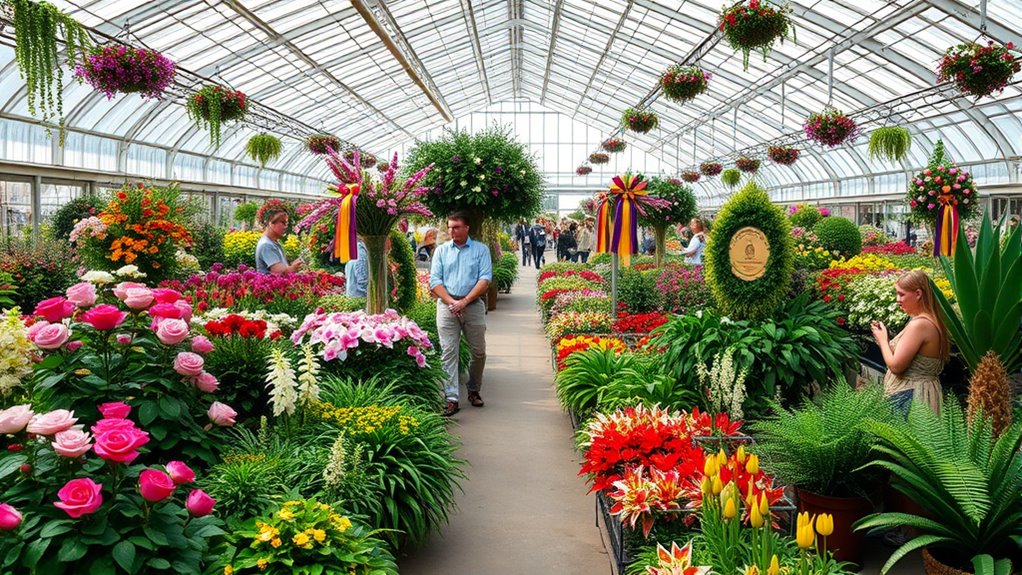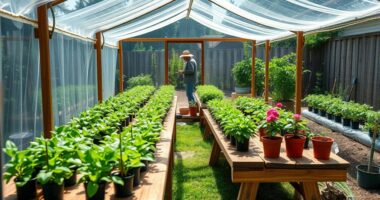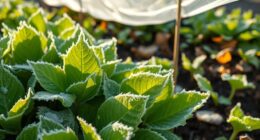At greenhouse competitions and shows, you can expect to showcase your plants, use innovative techniques, and create eye-catching displays. You’ll need to select diverse, healthy plants and present them professionally with clear labels. Educational activities like workshops and demos are common, offering hands-on learning and networking opportunities. Attention to detail, sustainability practices, and creativity count. If you want to discover tips for standing out and making the most of these events, keep exploring further.
Key Takeaways
- Competitions focus on diverse plant categories, creative arrangements, and innovative cultivation techniques, judged on health, presentation, and aesthetic appeal.
- Clear labeling, professional displays, and thoughtful organization enhance exhibitor presentations and visitor engagement.
- Educational activities like workshops and demonstrations deepen understanding and foster hands-on learning.
- Networking events provide opportunities to connect with industry partners, suppliers, and fellow horticulturists.
- Success relies on thorough preparation, sustainable practices, and demonstrating technical skill and creativity.
Overview of Greenhouse Events
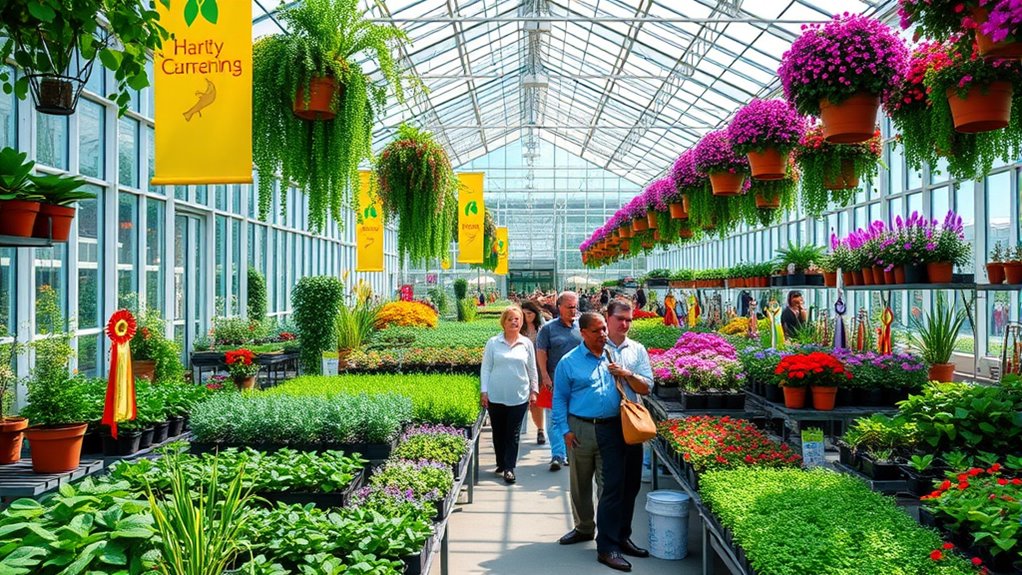
Have you ever wondered how greenhouse enthusiasts showcase their best work? Greenhouse events highlight current gardening trends and sustainable practices, bringing together passionate growers from around the world. These events range from local fairs to international exhibitions, offering opportunities to display innovative techniques and eco-friendly solutions. AI-driven insights are increasingly used to enhance the planning and organization of these events, making them more engaging and informative for attendees. Participants often present their plants, setups, and ideas that emphasize green practices, inspiring others to adopt more sustainable methods. Attendees can learn about the latest trends in organic gardening, water conservation, and eco-conscious design. These events foster a sense of community among growers, encouraging knowledge sharing and collaboration, and often incorporate eco-friendly practices into their planning to promote sustainability. Incorporating sustainable gardening methods can significantly improve the environmental impact of these events. For instance, utilizing water-saving techniques and sustainable materials can further reduce their ecological footprint. Additionally, showcasing innovative eco-solutions at these gatherings can motivate widespread adoption of greener gardening techniques. Whether you’re a seasoned gardener or a curious newcomer, greenhouse events are a vibrant platform to celebrate growth, creativity, and environmentally responsible gardening.
Types of Competitions and Shows
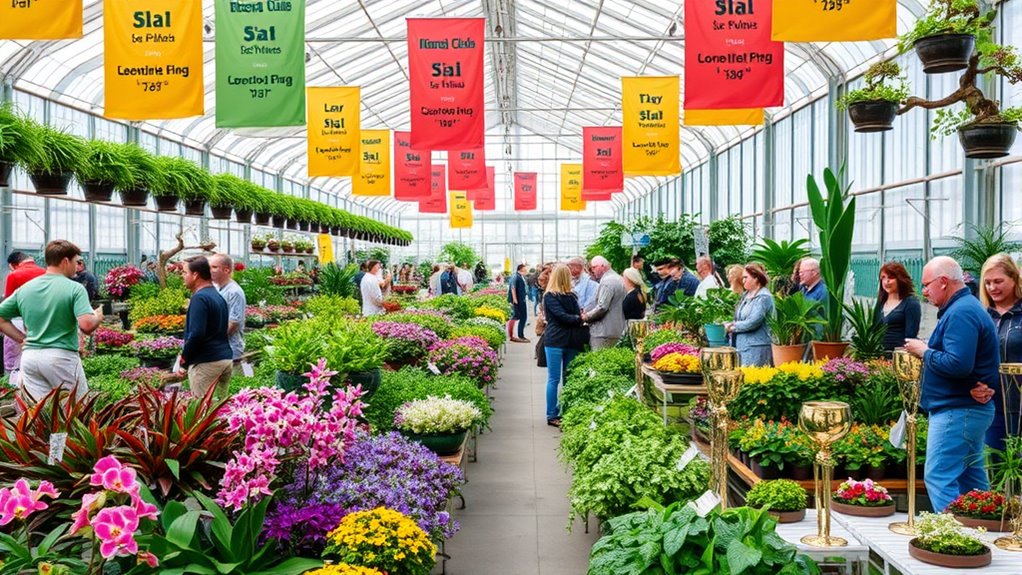
Greenhouse competitions and shows come in many formats, each designed to highlight different skills and achievements in horticulture. Some focus on specific plant categories, such as flowering plants, vegetables, or succulents, allowing you to showcase expertise in particular areas. Others are broader, judging displays based on criteria like plant health, presentation, and overall growth. Understanding the judging criteria helps you prepare your entries to meet the standards expected. For example, judges may evaluate plant vigor, symmetry, and pest-free condition. Different competitions may emphasize creative arrangements, scientific growth techniques, or innovative plant breeding. Recognizing these formats helps you tailor your efforts and increases your chances of success in each type of competition or show, especially considering the importance of maintaining healthy plant environments free from pests and diseases. Additionally, some competitions may have specific support hours or guidelines to assist participants in preparing their entries effectively. Being aware of celebrity transformations and lifestyle insights can also inspire creative presentation ideas that stand out in shows. Incorporating advanced cultivation techniques can further enhance the quality of your entries, giving you a competitive edge. Moreover, understanding self watering plant pots can be beneficial for maintaining consistent moisture levels during the cultivation process, ensuring plants remain healthy and vibrant throughout the competition.
What Participants Usually Submit
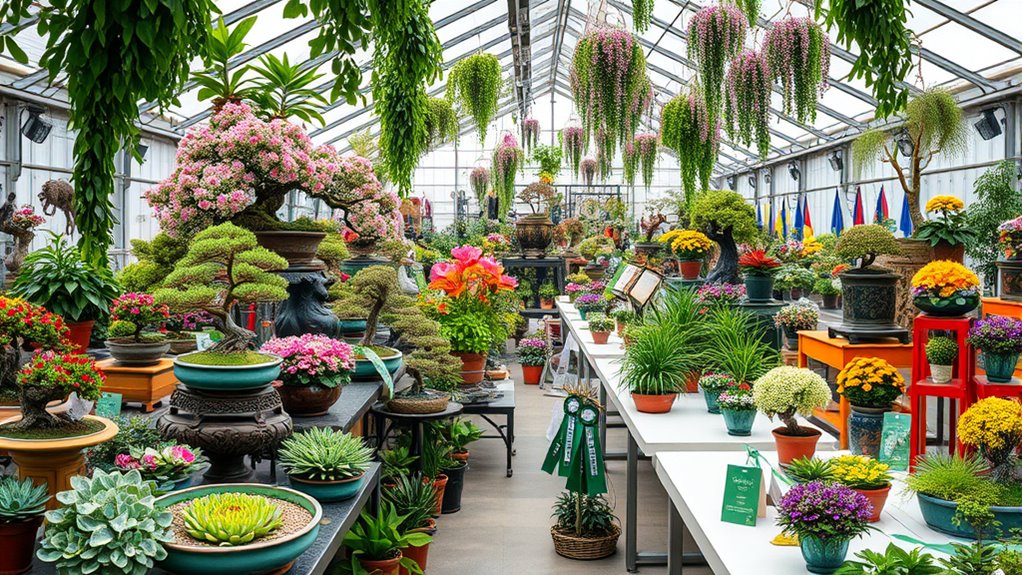
When participating, you’ll typically choose exciting plant varieties that showcase your skills. You might also experiment with innovative growing techniques to stand out. Don’t forget to focus on clear presentation and proper labeling to catch the judges’ attention. Incorporating hands-on learning experiences through creative cultivation methods can further demonstrate your knowledge and dedication. Additionally, understanding electric bike conversion kits can inspire sustainable practices and innovative approaches to gardening tools and equipment, highlighting your versatility as a participant. Exploring solar-powered garden equipment can also enhance your sustainability efforts and demonstrate eco-friendly innovation in your gardening projects. Being familiar with composting techniques can further improve your submissions by showcasing sustainable waste management practices. Recognizing conflict resolution skills can help foster a more collaborative and positive environment during competitions, promoting better teamwork and communication among participants.
Plant Selection and Variety
Participants in greenhouse competitions often select a diverse range of plant varieties to showcase their skills and creativity. Your variety selection is essential, as judges look for plants that demonstrate both health and unique qualities. Emphasizing plant diversity allows you to stand out and showcase your ability to grow different species successfully. When choosing plants, consider factors like color, form, and seasonality to create an eye-catching display. Avoid sticking to just one type; instead, mix flowering plants, foliage, and specialty varieties. This variety not only highlights your expertise but also appeals to judges’ appreciation for innovation and versatility. Careful curating of plant diversity reflects your dedication and understanding of horticultural principles, making your submission more compelling. Staying informed about plant selection strategies can further enhance your chances of success. Incorporating knowledge of garden design principles can also help you create more balanced and attractive displays. Additionally, understanding vibrational energy and how it influences plant health can inspire more intentional and successful cultivation techniques. Exploring plant health monitoring techniques can help ensure your plants remain vigorous and prize-worthy.
Innovative Growing Techniques
Innovative growing techniques help set your greenhouse display apart by demonstrating advanced horticultural skills. Many participants showcase hydroponic systems, which allow plants to grow without soil, using nutrient-rich water solutions. This method maximizes space and accelerates growth, making it ideal for competition settings. Additionally, incorporating sustainable practices such as rainwater harvesting and organic fertilizers can enhance the environmental friendliness of your setup. Vertical farming is another popular technique, stacking plants in multi-tiered structures to optimize limited space and produce high yields. These methods highlight your ability to incorporate modern technology and sustainable practices into traditional greenhouse setups.
Presentation and Labeling
Clear presentation and accurate labeling are essential components of a standout greenhouse display. When preparing your submission, focus on effective presentation techniques that highlight your plants’ best features.
Use clean, organized arrangements to draw attention and create visual appeal. Plant labeling should be clear, legible, and informative, providing essential details like plant name, variety, and growing conditions.
Well-designed labels not only inform judges but also demonstrate your professionalism. Pay attention to color coordination, symmetry, and overall aesthetics to make your exhibit inviting.
Key Features of Exhibition Displays
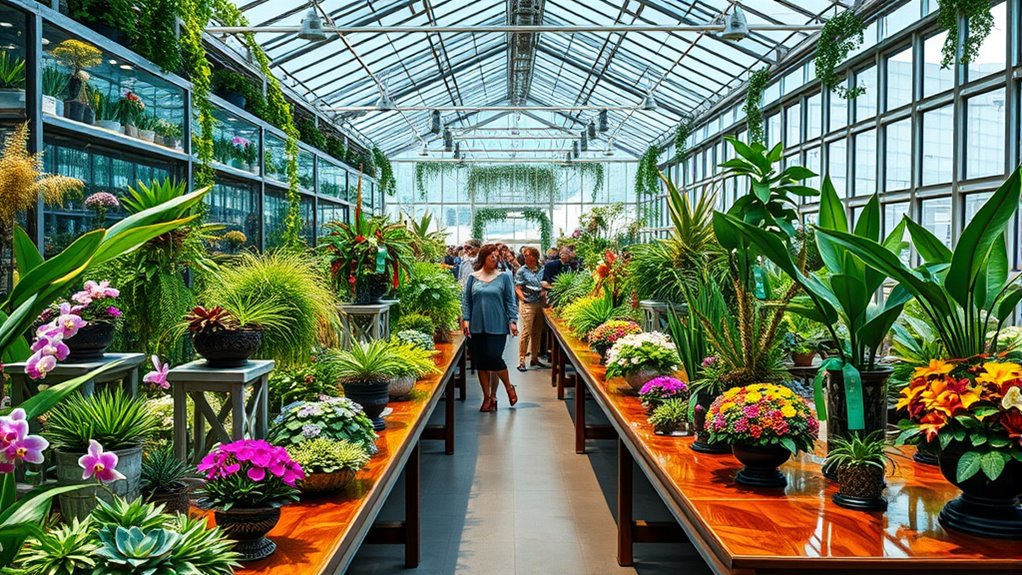
A well-designed exhibition display captures attention and effectively showcases the exhibit’s theme. Your plant display should be visually appealing and organized, highlighting key specimens. Signage design plays a vital role in guiding viewers and providing information clearly. Use bold headings and concise descriptions to draw focus. Consider the flow—arrange plants to lead visitors naturally through the display. The table below summarizes essential features:
| Feature | Purpose | Tip |
|---|---|---|
| Plant display | Showcase plant varieties | Use varied heights |
| Signage design | Communicate key info | Keep it simple and readable |
| Lighting | Highlight displays and details | Use soft, focused lights |
| Accessibility | Make display easily viewable | Ensure clear pathways |
Focus on these features to create an engaging, informative exhibit.
Educational Workshops and Demonstrations
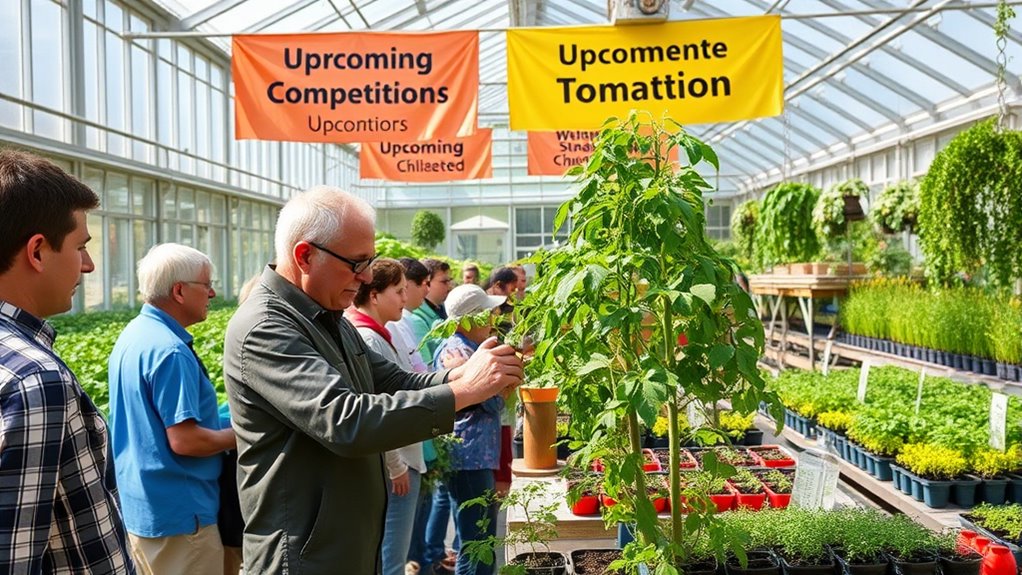
Building on the visual appeal of your exhibition, incorporating educational workshops and demonstrations can considerably enhance visitor engagement. You can showcase botanical art techniques, inspiring attendees to appreciate plant beauty and creativity.
Demonstrations on pest management strategies give visitors practical tips to protect their plants effectively. These interactive sessions encourage participation, making your exhibit memorable.
Consider offering mini-workshops on pruning, propagation, or sustainable gardening practices. Engaging visitors with hands-on activities not only educates but also fosters a deeper connection to your horticultural displays.
Networking and Industry Connections
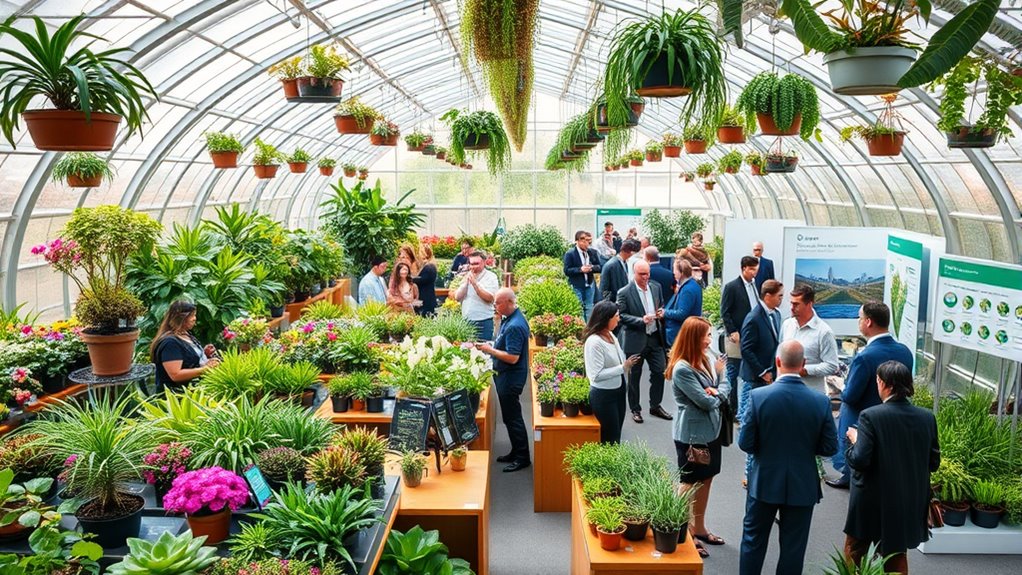
Establishing strong networking and industry connections can substantially boost the success of your greenhouse competitions and shows. Attending networking events allows you to meet industry partners, suppliers, and fellow growers who can offer valuable insights and support.
Building these relationships helps you stay updated on industry trends and innovations, which can improve your entries and overall presentation. Developing industry partnerships can lead to collaborations that enhance your resources and visibility.
Make sure to exchange contact information and follow up after events to solidify these connections. Engaging actively in these opportunities not only broadens your professional network but also opens doors for future sponsorships, mentorships, and joint ventures.
Strong industry ties give you a competitive edge and foster long-term growth in the greenhouse community.
Tips for Attending and Participating
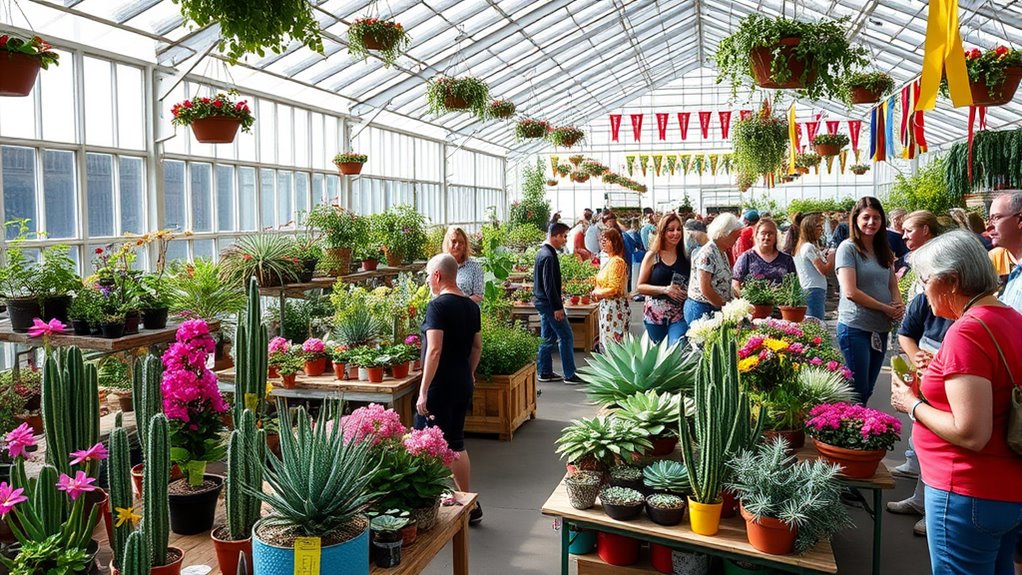
Wondering how to make the most of your greenhouse competition or show experience? Start by preparing your garden design carefully—consider theme, layout, and presentation to catch the judges’ eyes.
Practice your pest management skills to ensure your plants are healthy and free of issues, which reflects well on your expertise. Bring detailed notes or a portfolio to explain your design choices and pest control strategies.
Arrive early to set up and check all equipment. Engage with fellow participants and judges confidently, sharing insights and asking questions.
Stay attentive to rules and deadlines, and be ready to adapt if needed. Ultimately, a focus on innovative garden design and good pest management can make a lasting impression and boost your chances of success.
Opportunities for Inspiration and Innovation
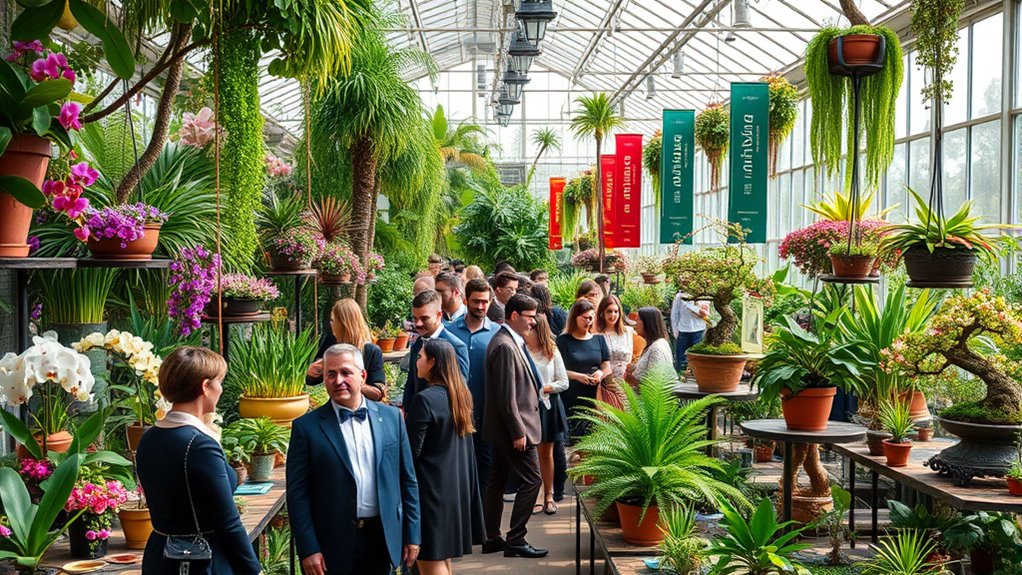
Where do you find fresh ideas for your greenhouse projects? Greenhouse competitions and shows are perfect opportunities to spark inspiration and explore innovative concepts. You can observe cutting-edge plant breeding techniques that push the boundaries of yield, flavor, and resilience.
Participating in or attending these events exposes you to sustainable practices that reduce environmental impact while boosting productivity. Seeing how others experiment with new growing methods or hybrid varieties can inspire you to adapt these innovations to your own setup.
Networking with industry experts and fellow enthusiasts also opens doors to collaborative ideas and feedback. These events challenge you to think creatively, implement sustainable solutions, and stay ahead of trends—making your greenhouse both more productive and environmentally friendly.
Frequently Asked Questions
How Are Winners Selected in Greenhouse Competitions?
You might wonder how winners are chosen in greenhouse competitions. Judges evaluate entries based on specific judging criteria like plant health, growth quality, and presentation. They carefully assess each entry, comparing how well they meet these standards.
Prize selection then follows, rewarding the entries that excel most according to the criteria. This process guarantees fairness and highlights the best growers and plants, making the competition both exciting and transparent.
What Safety Protocols Are in Place at These Events?
You should know that safety measures at these events are strict to keep everyone safe. Organizers implement emergency procedures like first aid stations, fire exits, and clear signage.
Staff are trained to respond quickly to any incidents, ensuring a safe environment. Always follow posted instructions and listen to staff announcements.
These protocols help prevent accidents and provide quick assistance if emergencies arise, giving you peace of mind while enjoying the event.
Are There Age Restrictions for Participants?
You might wonder if age restrictions limit your involvement, adding a hint of suspense. Typically, these events encourage youth participation, but specific age restrictions vary.
Some competitions welcome young growers, fostering future talent, while others may set age limits to guarantee fairness. Check the event’s rules carefully, as understanding these restrictions can be the key to opening your chance to compete and showcase your green thumb.
How Can Beginners Get Involved in Greenhouse Shows?
If you’re a beginner wanting to join greenhouse shows, start with simple garden planning and focus on plant selection.
Research easy-to-grow plants suited for your climate, and practice cultivating healthy specimens.
Attend local workshops or connect with experienced growers for tips.
Don’t worry about perfection—use each experience to learn.
Participating is about sharing your passion, gaining knowledge, and having fun, so immerse yourself and enjoy the process!
What Are the Costs Associated With Participating?
When you consider participating, you’ll need to account for entry fees, which vary depending on the show, and equipment costs, including supplies and tools. These expenses can range from modest to significant, so budgeting ahead helps.
You might also need to invest in specific plants or materials. By planning carefully, you guarantee your participation is manageable and enjoyable without unexpected financial surprises.
Conclusion
Attending greenhouse competitions and shows offers endless opportunities to learn, connect, and innovate. Whether you’re showcasing your best plants or gaining new skills, these events inspire growth and creativity. Remember, “A picture is worth a thousand words,” so take in the displays and demonstrations to spark your own ideas. Immerse yourself with an open mind and a curious spirit—you never know what seeds you might plant for future success.
